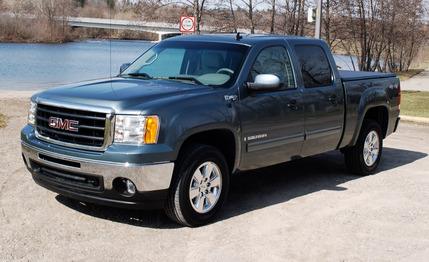
 Short Take Road Test
Short Take Road Test
Regardless of the vehicle class, there are two basic reasons for paying the price premium that goes with a hybrid.
Reason one: You want to reduce your monthly fuel bill.
Reason two: You’re convinced that carbon dioxide is indeed a global peril, and even though motor vehicles account for a tiny percentage of it, you want to reduce your contribution.


Whatever your motivation, if you’re thinking hybrid, and your needs include a full-size pickup, your options are limited to one of two essentially identical trucks—the GMC Sierra here, or its Chevrolet Silverado sibling. General Motors is the only manufacturer offering hybrids in this segment, leading the way with impressive technology sourced from its current hybrid SUVs: a sophisticated two-mode continuously variable transmission to deal with electric motor motivation (potentially up to 30 mph), plus GM’s Active Fuel Management, which shuts down four of the engine’s eight cylinders at steady cruising speeds. (Chrysler tells us it has a Hemi-powered Dodge Ram hybrid on the way, but the GM twins are the only hybrid pickups you can buy now.)
But aside from higher EPA fuel economy expectations—20 mpg city/20 mpg highway—what do you actually get for the extra money?
Costs vs. Convictions
Let’s look at the numbers. A four-wheel-drive GMC Sierra 1500 crew cab pickup carries a base price of $36,980 when fitted with a 5.3-liter V-8 producing 315 hp and 338 lb-ft of torque. Add $2550 if you want the 6.0-liter V-8 and its 367 hp and 375 lb-ft. We mention the bigger engine option for parallelism because a milder, all-aluminum version of that powerplant is employed in the Sierra hybrid.
Four-wheel-drive Sierra hybrids carry a base price of $42,535. Our Sierra’s as-tested price came in at $48,670 with the 3HB trim package, which includes luxuries such as navigation, a Bose premium stereo, and leather seating. Its V-8 is rated for 332 hp and 367 lb-ft, augmented by a pair of electric motors that can add up to 80 hp and 236 lb-ft. The conventional 6.0-liter Sierra 4x4 is EPA-rated to deliver 13 mpg city/18 mpg highway; the hybrid, 20/20.
That’s a significant difference, but our experiences with this truck—and a virtually identical Silverado hybrid—didn’t quite measure up to the EPA’s expectations. We logged 14 mpg with the Silverado hybrid, and that included about 300 miles of towing a 4600-pound trailer; we managed a little over 16 mpg with the unladen Sierra hybrid.
We undoubtedly would have fared worse with the conventional 6.0-liter Sierra, but the question that arises is obvious: How many miles would the Sierra hybrid owner have to log to recoup the thousands extra paid for hybridization? When fuel was hovering around $4 a gallon, this proposition looked more attractive. But at $2.00 or $2.50 per, the break-even point slides much further toward the horizon.
Philosophy vs. Practicality
Besides the higher price, there are a couple other practical disincentives: lower payloads and lower trailering limits. The Sierra hybrid towed our trailer capably, but its upper limit is 6100 pounds. A conventional four-wheel-drive, 6.0-liter Sierra is good for 9500 pounds and can handle up to 10,400 with the max trailering option ($1155). The hybrid’s payload tops out at 1418 pounds, and a conventional Sierra crew cab with the 6.0-liter is rated for 1714.
Hybrid owners can also expect more leisurely acceleration, about a half-second slower to 60 mph (8.2 seconds) and in the quarter-mile (16.3 seconds at 87 mph), than nonhybrid versions, although this shouldn’t be an issue for a potential owner. No one buys trucks like this to go fast.
A Smooth Operator
Like all GM full-size pickups, the Sierra hybrid is a lovely truck to live with—smooth, quiet, eminently civilized, and nicely finished inside and out. Although Ford and Dodge have caught up in terms of foundations, the GMs are still solid trucks, with a first-rate chassis, the basis of respectable dynamics, and creamy ride quality. There are a couple areas that could be improved, though, such as the numb steering, which is a soft point for all GM’s big pickups. And the hybrid could give its owners a bit more psychological reward than the vague little econ gauge in the upper left corner of the instrument panel.
One of the key elements in the success of the Toyota Prius is its graphic display that tells the operator when the car is running on battery power, the state of the battery pack, etc. That sort of feedback is conspicuous by its absence in the GM hybrids. The driver knows when the truck is moving under electric power by a subdued whirring, and he knows when he’s getting some battery regeneration via braking once he’s learned how to interpret that little gauge.
But that’s it. And when we got to the bottom of our conventional-versus-hybrid checklist, we found that the only potentially compelling plus in the hybrid column is one that’s pretty ethereal: the prospective owner’s desire to have big-truck capability while reducing his so-called carbon footprint. If that makes you feel better, this ride is for you. For our money, though, there are much better buys in GM’s full-size-pickup inventory.